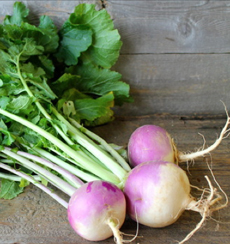RECIPE: Turnip Soup
 Today is pretty chilly, so we’re making turnip soup. Photo and recipe courtesy Quinciple. |
Turnips are part of the super-potent cruciferous vegetables* group, from which we try to eat daily. There’s more about the family below.
We’ve enjoyed mashed, purée, roasted and stir-fried turnips, and we’ve fried and baked them in the manner of sweet potato fries. But until now, we never tried turnip soup, a comfort food that can be crowned with garnishes from apples and chives to crumbled bacon and shredded cheese. Although the soup looks creamy, there’s no dairy. The rich color and texture come from the gold turnips. If you can only find white turnips, you can add a some carrots for color, or just enjoy the pale soup. But gold turnip are noted for their “bonus” flavor, slightly sweet with a nutty nuance of almond. The recipe is courtesy Quinciple, a subscription service that delivers the week’s best fresh produce. |
|
|
RECIPE: GOLD BALL TURNIP SOUP WITH APPLES Ingredients †Wait until ready to serve to slice the apples, so they don’t brown. Leave the skin on for a touch of color. 1. PREHEAT the oven to 400°F. Cut the turnips and onion into ½” cubes. Toss with two tablespoons of olive oil and season with salt and pepper. Arrange in a single layer on a baking sheet. 2. ROAST until the turnips are tender, about 15-20 minutes. Purée the roasted turnips and onions with the stock, and add enough water to achieve a smooth consistency. 3. WARM the soup in a small pan. Taste and adjust the seasonings. To serve, garnish with apple slices, herbs and a drizzle of olive oil. |
||
|
GOLD TURNIPS HISTORY There are several varieties of gold turnips, heirloom varieties from Europe that were first grown in France in the 1800s. In the U.S. they are marketed variously as Baby Gold, Boule D’or (the prized French variety, which translates to “golden ball”), Golden Ball and Golden Globe turnips. Gold turnips are a less durable than the common white and purple-white varieties, as they are not a good “cellar vegetable.” This means that they will not maintain their firmness and flavor if stored throughout the winter—a prized feature of turnips, rutabagas and other root vegetables in the days before refrigeration. Turnip were cultivated as far back as the Greek Hellenistic Period, 321 B.C.E. to 31 B.C.E. They grow from fall through spring, and can’t tolerate summer heat. Gold turnips can replace common turnips in any recipe, and provide more flare due to their color. In fact, they can pretty much be used anywhere carrots are used, as well. In addition to cooked recipes, turnips (white and gold) can be eaten raw as crudités and in salads. They can be shredded into a slaw along with cabbage and carrots, and tossed with a Dijon vinaigrette. The leaves can also be eaten raw or cooked. Per SpecialtyProduce.com, the flavor is truly transformed and sweetened when they are slow roasted, braised or sautéed in butter. Good accents include: |

|
|
|
THE CRUCIFEROUS VEGETABLES FAMILY The turnip is a cruciferous vegetable, a member of the Brassicaceae family of cancer-fighting superfoods. They are also called the brassicas, after their family name. “Cruciferous” derives from cruciferae, New Latin for “cross-bearing.” It refers to the flowers of these vegetables, which consist of four petals in the shape of a cross. The family includes arugula, bok choy, broccoli, Brussels sprouts, cabbage, cauliflower, collard greens, horseradish, kale, kohlrabi, mizuna, mustard greens, radish, rapeseed/canola, rapini (broccoli rabe), rutabaga, tatsoi and turnips. Cruciferous vegetables are low in calories and high in fiber, vitamins and minerals. You can’t eat too many of them, but you can overcook them. Like broccoli, Brussels sprouts and the rest of the family, cruciferous vegetables contain chemical compounds that, when exposed to heat for a sufficient amount of time, produce hydrogen sulfide (an unpleasant sulfur aroma). So take care not to overcook them.
|
||



